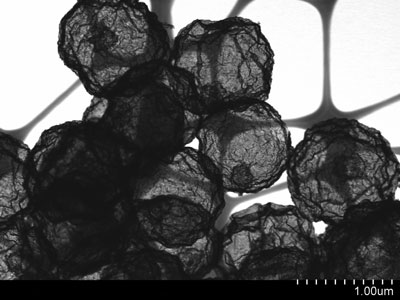| Posted: Mar 03, 2010 | |
Smart capsules for water treatment with recyclable carbon nanotube cores |
|
| (Nanowerk Spotlight) Numerous nanomaterials are in various stages of research and development, each possessing unique functionalities that are potentially applicable to the remediation of industrial wastewater, groundwater, surface water and drinking water. The main goal for most of this research is to develop low-cost and environmentally friendly materials for removal of heavy metals from water (read more: "Applying nanotechnology to water treatment"). | |
| Drinking or ground water could be contaminated by heavy metal ions such as lead, chromium, and arsen discarded from industrial waste water. These heavy metal ions are regarded as highly toxic pollutants which could cause a wide range of health problem in case of a long-term accumulation in the body (see: "Science and technology for water purification in the coming decades"). | |
| Among various candidates, hierarchically structured metal oxide materials have been widely used as removal agents for various heavy metal ions and their removal capacity was found to be relatively reliable. | |
| In the case of metal oxide species, the removal mechanism for heavy metal ions is thought to be the formation of a strong bond between metal ions and metal oxide surfaces. This strong complexation is advantageous for complete removal of heavy metal ions but it presents a drawback if one wants to design a reusable agent by reviving the reaction site for heavy metal ions. Precisely because the removal mechanism is based on the strong complex formation between metal ions and oxide surfaces, recycling of these removal agents has proved to be difficult. | |
| It still remains a great challenge to regenerate the active surface after a metal ion complexation reaction. If one could build a recyclable agent for removal of heavy metal ions this would be a very beneficial way to reduce the cost for purification of water and an environmental-friendly way to use of materials at the same time. | |
| Offering a potential solution, researchers in South Korea have demonstrated a recyclable removal agent for heavy metal ions by fabricating a core-in-shell structure based on a core of carbon nanotubes (CNT) and an iron oxide (hematite) microcapsule structure (the shell) – a structure they refer to as CNT core-in-hematite shell capsule. | |
 |
|
| TEM image of the CNT core-in-hematite shell structures. (Image: Dr. Choi, KBSI) | |
| As Won San Choi, a professor at the Korea Basic Science Institute (KBSI), explains to Nanowerk, this kind of core-in shell structures could be a promising candidate for removing heavy metal ions due to two main reasons: 1) core structures can provide a high surface area where functional groups can react with heavy metal ions; 2) shell structures can provide a mechanical robustness against wear and tear, and facile mass transportation. | |
| "An additional remarkable advantage of core-in-shell structures is that aggregation of cores after reaction can be avoided by shell structures," says Choi. "The carbon nanotubes inside the capsules can be reconfigured from a conglomerate to individual nanotubes by heat treatment and sonication. The metal ions adsorbed onto the CNT cores could be reversibly desorbed upon exposure to a low pH, thus the resulting capsules could be used as an efficient, reusable agent for heavy metal ion removal. Since the hematite shell could provide protection against massive aggregation of each CNT cores upon ion complexation, the resulting capsule structures could be an excellent candidate for heavy metal ions removal." | |
| This protocol, reported in the February 1, 2010 online issue of Advanced Functional Materials ("Smart Microcapsules Encapsulating Reconfigurable Carbon Nanotube Cores"), opens a promising route for the preparation of feasible, environmental friendly – and most importantly – reusable agent for heavy metal ion removal. | |
| To fabricate their core-in-shell capsules, Choi and his team formed spherical CNT aggregates which were individually encapsulated into the interior of the hematite capsule. By repetitive cycles of sonication and heat treatment, the encapsulated CNT cores showed reversible disassembly and assembly within the capsules. | |
| "The CNTs inside the capsules enabled lead or chromium ions to be easily adsorbed, and exposure to a low pH resulted in desorption of the heavy metal ions" says Choi. "We have now demonstrated one application of this kind of core-in-shell microcapsules as a removal agent for heavy metal ions. But, this kind of structure also could be used for many potential applications including chemical sensors, microreactors, catalysts, drug carriers, and encapsulation studies." | |
 By
Michael
Berger
– Michael is author of three books by the Royal Society of Chemistry:
Nano-Society: Pushing the Boundaries of Technology,
Nanotechnology: The Future is Tiny, and
Nanoengineering: The Skills and Tools Making Technology Invisible
Copyright ©
Nanowerk LLC
By
Michael
Berger
– Michael is author of three books by the Royal Society of Chemistry:
Nano-Society: Pushing the Boundaries of Technology,
Nanotechnology: The Future is Tiny, and
Nanoengineering: The Skills and Tools Making Technology Invisible
Copyright ©
Nanowerk LLC
|
|
|
Become a Spotlight guest author! Join our large and growing group of guest contributors. Have you just published a scientific paper or have other exciting developments to share with the nanotechnology community? Here is how to publish on nanowerk.com. |
|
